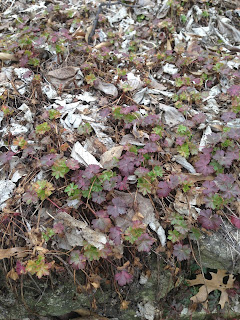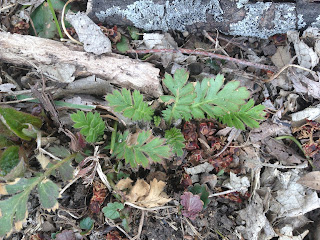So my snowdrops have been blooming since January and the bulb iris is already done. However, now is the time when plants are beginning to emerge from the soil as temperatures warm and days lengthen. I have a friend who bought a new house in the fall. She is trying to figure out all the new things popping up in the yard. I thought I'd do a permabulation of the estate and take pictures of what's popping it's head up. Call it Name That Plant - Spring Version. Just ignore the creeping Charlie.
Daffodils
How you can tell: Daffodils are monocots, so they have long slender leaves with parallel veins. Look for rounded tips, but for me, what really indicates that they are daffodils is the twist in the foliage. It looks kind of like a group of eels.
Katharine Hodgkin iris
How you can tell: This dwarf iris is in the reticulate group, which means you plant them as bulbs and they'll go dormant in June. These tiny little gems come up in March and bloom for maybe a week. They are fleeting, but so so lovely. After they flower, they will send up grey-green spikes of narrow foliage that should be allowed to wither naturally.
Allium and tulips
How you can tell: The grey green foliage is allium, the kind that send up a purple ball of flowers later in spring. It is narrower than its neighboring tulips and the foliage is held in a stalk at the base. The tulips are beefy mid-green leaves in a big cluster with a little ripple in the edges at this stage.
Daisies
How you can tell: Well, partly it's because I know where they are and I leave the stalks up for winter interest. However, they do leaf out early in flat clusters of lightly toothed rounded leaves.
Bearded iris
How you can tell: The fans of iris are very flat. See how they are organized in one layer? Another monocot, they are usually a grey-green or have a greyish cast to them. Not to be confused with...
Daylilies
How you can tell: Daylilies, although organized in fans, tend to be bunchier, not as flat as iris. They also tend to be a light green with maybe a greyish cast. They are fleshier, too. Mine were none too pleased with our late snow, and are showing some frost damage in the form of seared foliage.
Monarda or bee balm
How you can tell: Most monardas emerge with a purple tinge to their slight fuzzy corrugated arrowhead leaves. The round leaves in the photo are creeping Charlie. Monarda is also minty fragrant when crushed.
Rhubarb
How you can tell: They look like brains. Also, they are showing their characteristic red stems. Rhubarb is super cool as it emerges (brains!), so it's something worth checking on if you don't have it front and center.
Scilla
How you can tell: This minor bulb is just beginning to flower in my garden. They are only about three inches high, have a touch of purple in the stems, and nodding flowers. As the flowers age, they open up more.
Sedum
How you can tell: This is a groundcover type of sedum. The leaves are succulent and on wiry stems. They are also a little seared by the snow. Groundcover sedums are up now and hug the ground. Many have a touch of red in the leaves.
Geranium or cranesbill
How you can tell: This is a grouncover type of geranium. Its newly emerging leaves are red as the chlorophyll hasn't kicked in yet. They are palmate in shape and spicy fragrant when crushed.
Jacob's ladder
How you can tell: See how the leaves are organized like a feather? Jacob's ladder (Polemonium reptans) are pinnately compound and cute as pie. They will be a clean green when mature, but for now have a bit of purple.
Prairie smoke
How you can tell: Another pinnately compound perennial, prairie smoke (Geum triflorum) is semi-evergreen and a nice polite native. They are also fuzzy and organize themselves in clumps. Soon their signature flowers will pop up.
Shooting star
How you can tell: Shooting star (Dodecatheon meadia) has lettuce-green leaves in small rolls. Part of this is that I know where I put it and I keep an eye on it. The bunnies will occasionally snack. I'm hoping to get some nice big clumps going, but for now I'm just happy it's back.
I hope this is helpful as you stroll the yard and start the spring clean up. Are you ready?


















No comments:
Post a Comment